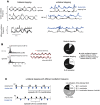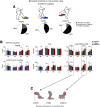Left-Right Locomotor Coordination in Human Neonates
- PMID: 35831172
- PMCID: PMC9410754
- DOI: 10.1523/JNEUROSCI.0612-22.2022
Left-Right Locomotor Coordination in Human Neonates
Abstract
Terrestrial locomotion requires coordinated bilateral activation of limb muscles, with left-right alternation in walking or running, and synchronous activation in hopping or skipping. The neural mechanisms involved in interlimb coordination at birth are well known in different mammalian species, but less so in humans. Here, 46 neonates (of either sex) performed bilateral and unilateral stepping with one leg blocked in different positions. By recording EMG activities of lower-limb muscles, we observed episodes of left-right alternating or synchronous coordination. In most cases, the frequency of EMG oscillations during sequences of consecutive steps was approximately similar between the two sides, but in some cases it was considerably different, with episodes of 2:1 interlimb coordination and episodes of activity deletions on the blocked side. Hip position of the blocked limb significantly affected ipsilateral, but not contralateral, muscle activities. Thus, hip extension backward engaged hip flexor muscle, and hip flexion engaged hip extensors. Moreover, the sudden release of the blocked limb in the posterior position elicited the immediate initiation of the swing phase of the limb, with hip flexion and a burst of an ankle flexor muscle. Extensor muscles showed load responses at midstance. The variable interlimb coordination and its incomplete sensory modulation suggest that the neonatal locomotor networks do not operate in the same manner as in mature locomotion, also because of the limited cortical control at birth. These neonatal mechanisms share many properties with spinal mammalian preparations (i.e., independent pattern generators for each limb, and for flexor and extensor muscles, load, and hip position feedback).SIGNIFICANCE STATEMENT Bilateral coupling and reciprocal activation of flexor and extensor burst generators represent the fundamental mechanisms used by mammalian limbed locomotion. Considerable progress has been made in deciphering the early development of the spinal networks and left-right coordination in different mammals, but less is known about human newborns. We compared bilateral and unilateral stepping in human neonates, where cortical control is still underdeveloped. We found neonatal mechanisms that share many properties with spinal mammalian preparations (i.e., independent pattern generators for each limb, the independent generators for flexor and extensor muscles, load, and hip-position feedback. The variable interlimb coordination and its incomplete sensory modulation suggest that the human neonatal locomotor networks do not operate in the same manner as in mature locomotion.
Keywords: early development; human locomotion; interlimb coordination; neonatal stepping.
Copyright © 2022 the authors.
Figures









References
-
- Apgar V (1953) A proposal for a new method of evaluation of the newborn infant. Curr Res Anesth Analg 32:260–267. - PubMed
-
- Batschelet E (1981) Circular statistics in biology. London, New York: Academic.
Publication types
MeSH terms
LinkOut - more resources
Full Text Sources
